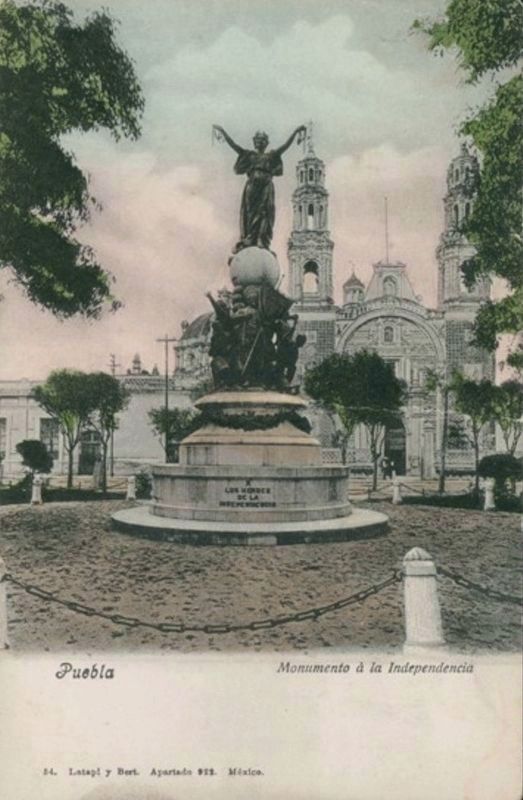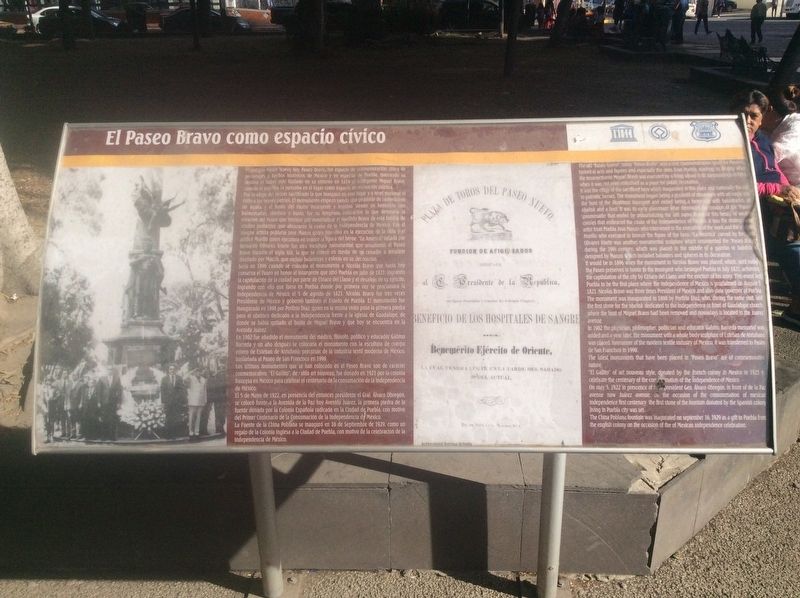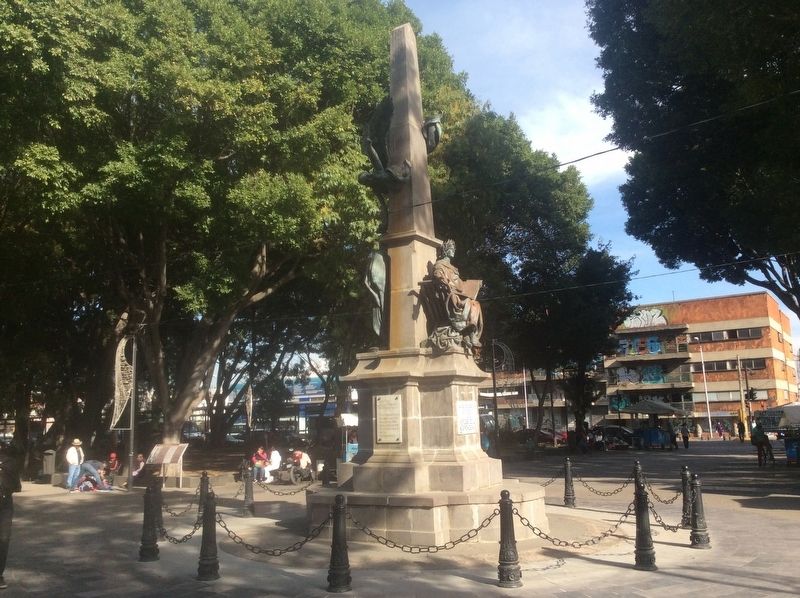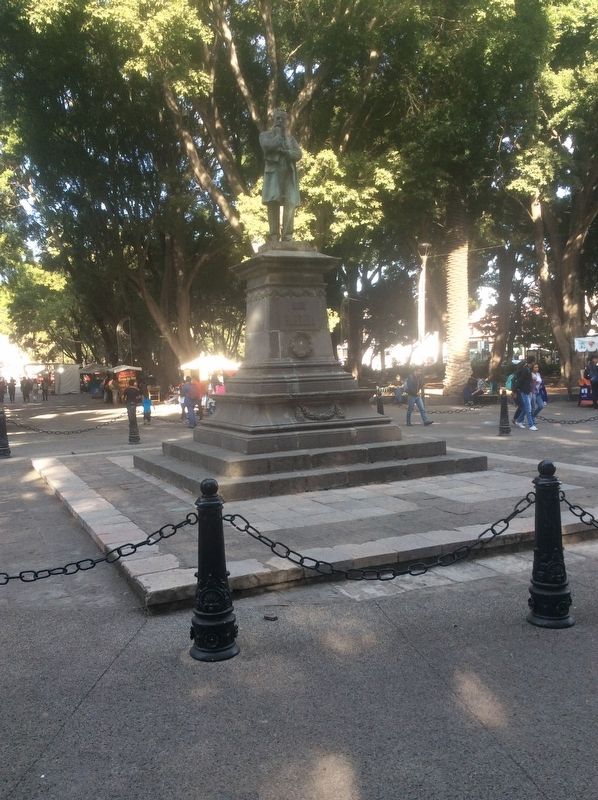Puebla, Mexico — The Central Highlands (North America)
The "Paseo Bravo" as a Civic Space
El Paseo Bravo como espacio cívico
El antiguo Paseo Nuevo, hoy Paseo Bravo, fue espacio de conmemoración cívica de personajes y hechos históricos de México y en especial de Puebla, marcando su destino el haber sido fusilado en su entorno en 1814 el Insurgente Miguel Bravo, cuando ni siquiera se pensaba en el lugar como espacio de recreación pública.
Fue la efigie del prócer sacrificado la que inauguró en este lugar y a nível nacional el culto a los héroes patrios. El monumento empezó siendo una pirámide de cantería con un águila y el busto del ilustre insurgente y terminó siendo un hemiciclo con balaustradas, obelisco y busto. Fue su temprana colocación lo que detonaría la creación del Paseo que terminó por inmortalizar el apellido Bravo de esta familia de criollos pudientes que abrazaron la causa de independencia de México. Fue el insigne artista poblano José Manzo quien intervino en la ejecución de la obra y el artífice Murillo quien ejecutara en bronce la figura del héroe. “La América” tallada por Bernardo Olivares Iriarte fue otra escultura monumental que ornamentó el Paseo Bravo durante el siglo XIX, la que se colocó en medio de un cenador o templete diseñado por Manzo, que incluía balaustres y esferas en su decoración.
Sería en 1896 cuando se colocara el monumento a Nicolás Bravo que hasta hoy conserva el Paseo en honor al insurgente que sitió Puebla en julio de 1821, logrando la capitulación de la ciudad por parte de Ciriaco del Llano y el desalojo de su ejército, logrando con ello que fuera en Puebla donde por primera vez se proclamara la Independencia de México el 5 de agosto de 1821. Nicolás Bravo fue tres veces Presidente de México y gobernó también el Estado de Pueba. El monumento fue inaugurado en 1898 por Porifirio Díaz, quien en la misma visita puso la primera piedra para el obelisco dedicado a la Independencia frente a la Iglesia de Guadalupe, de donde se habia quitado el busto de Miguel Bravo y que hoy se encuentra en la Avenida Juárez.
En 1902 fue añadido el monumento del médico, filósofo, político y educador Gabino Barreda y un año después se colocaría el monumento con la escultura de cuerpo entero de Esteban de Antuñano, precursor de la industia textil moderna de México, trasladada al Paseo de San Francisco en 1990.
Los últimos monumentos que se han colocado en el Paseo Bravo son de carácter conmemorativo.“El Gallito”, de estilo art nouveau, fue donado en 1921 por la colonia francesa en México para celebrar el centenario de la consumación de la Independencia de México.
El 5 de Mayo de 1922, en presencia del entonces presidente el Gral. Álvaro Obregón, se colocó frente a la Avenida de la Paz, hoy Avenida Juárez, la primera piedra de la fuente
donada por la Colonia Española radicada en la Ciudad de Puebla, con motivo del Primer Centenario de la Consumación de la Independencia de México.
La Fuente de la China Poblana se inauguró en 16 de Septiembre de 1929, como un regalo de la Colonia Inglesa a la Ciudad de Puebla, con motivo de la celebración de la Independencia de México.
English:
The “Paseo Bravo” as a Civic Space
The old “Paseo Nuevo”, today “Paseo Bravo”, was a civic commemoration space for Mexico’s historical acts and figures and especially the ones from Puebla, marking its destiny when the Insurrectionist Miguel Bravo was executed by a firing squad in its surroundings in 1814 when it was not even conceived as a place for public recreation.
It was the effigy of the sacrificed hero which inaugurated in this place and nationally the cult to patriotic heroes. The monument began being a pyramid of stonework with an eagle and the bust of the illustrious insurgent, and ended being a hemicycle with balustrades, an obelisk and a bust. It was its early placement what detonated the creation of the “Paseo” (promenade) that ended by immortalizing the last name Bravo of this family of wealthy creoles that embraced the cause of the independence of Mexico. It was the distinguished artist from Puebla José Manzo who intervened in the execution of the work and the sculptor Murillo who
executed in bronze the figure of the hero “La America” carved by Bernardo Olivares Iriarte was another monumental sculpture which ornamented the “Paseo Bravo” during the 19th century, which was placed in the middle of a gazebo or bandstand designed by Manzo, which included balusters and spheres in its decoration.
It would be in 1896 when the monument to Nicolas Bravo was placed, which, until today the Paseo preserves in honor to the insurgent who besieged Puebla in July 1821, achieving the capitulation of the city by Ciriaco del Llano and the eviction of his army. This event led Puebla to be the first place where the Independence of Mexico is proclaimed on August 5 1821. Nicolas Bravo was three times President of Mexico and also state governor of Puebla. The monument was inaugurated in 1898 by Porfirio Díaz, who, during the same visit, laid the first Stone for the obelisk dedicated to the Independence in front of Guadalupe church, where the bust of Miguel Bravo had been removed and nowadays is located in the Juarez avenue.
In 1902 the physician, philosopher, politician and educator Gabino Barreda memorial was added and a year later, the monument with a whole body sculpture of Esteban de Antuñano was placed, forerunner of the modern textile industry of Mexico; it was transferred to Paseo de San Francisco in 1990.
The latest monuments that have been placed

4. The 1898 Monument to Independence on the "Paseo Bravo"
This previous monument is mentioned in the marker text: "...laid the first Stone for the obelisk dedicated to the Independence in front of Guadalupe church, where the bust of Miguel Bravo had been removed and nowadays is located in the Juarez avenue."
“El Gallito” of art noveau style, donated by the French colony in Mexico in 1921 to celebrate the centenary of the consummation of the Independence of Mexico. On may 5, 1922 in prescence of then president Gen. Álvaro Obregón, in front of de la Paz avenue now Juárez avenue, on the occasion of the consummation of Mexican independence first centenary the first stone of the fountain donated by the Spanish colony living in Puebla city was set.
The China Poblana fountain was inagurated on september 16, 1929 as a gift to Puebla from the English colony on the occasion of the of Mexican independence celebration.
Topics. This historical marker is listed in these topic lists: Arts, Letters, Music • Charity & Public Work • Parks & Recreational Areas • Wars, Non-US. A significant historical month for this entry is July 1821.
Location. 19° 2.79′ N, 98° 12.477′ W. Marker is in Puebla. Marker can be reached from Calle 11 Sur just south of Avenida 3 Poniente, on the right when traveling south. The marker is almost directly in the center of the Paseo Bravo, near the monument to Nicolás Bravo. Touch for map. Marker is in this post office area: Puebla 72000, Mexico. Touch for directions.
Other nearby markers. At least 8 other markers are within walking distance of this marker. Nicolás Bravo (a few steps from this marker); The Old College of San Javier (about 210 meters away, measured in a direct line); The Museum of the Mexican Army and Air Force (about 210 meters away); The Church of Guadalupe (approx. 0.3 kilometers away); The House of the Little Heads (approx. 0.6 kilometers away); The Saint Augustine Church (approx. 0.6 kilometers away); The José Luis Bello y González Museum (approx. 0.8 kilometers away); Mail Car NM 2555 (approx. 0.8 kilometers away). Touch for a list and map of all markers in Puebla.
Credits. This page was last revised on October 3, 2022. It was originally submitted on January 16, 2018, by J. Makali Bruton of Accra, Ghana. This page has been viewed 187 times since then and 29 times this year. Photos: 1, 2, 3. submitted on January 16, 2018, by J. Makali Bruton of Accra, Ghana. 4. submitted on January 22, 2018, by J. Makali Bruton of Accra, Ghana.


